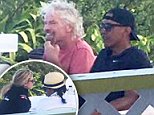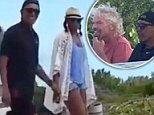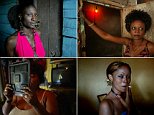The incredible two BILLION pixel image of the universe that reveals the celestial cat's paw meeting the cosmic lobster
- Image from the Very Large Telescope uses two billion pictures to display the Cat’s Paw and Lobster nebulae
- These objects were first detected in 1837, and sit 5500 and 8000 light-years away from Earth, respectively
- Telescopes are able to see three of 'toepads' of the Paw and claw-like regions of the nearby Lobster Nebyla
Two nebulae in the ‘stinging tail’ of the constellation Scorpius can be seen in stunning new detail in one of largest images ever released by the ESO.
The new picture from the Very Large Telescope uses roughly two billion pictures to display the Cat’s Paw and Lobster nebulae, which sit 5500 and 8000 light-years away from Earth.
Observation capabilities have come a long way since the objects were first spotted in 1837, but even with the powerful new instruments, thick dust in the nebulae keeps much of their content hidden.
Use your mouse or the slider to zoom in and out of the image
Two nebulae in the ‘stinging tail’ of the constellation Scorpius can be seen in stunning new detail in one of largest images ever released by the ESO. The new picture from the Very Large Telescope uses roughly two billion pictures to display the Cat’s Paw and Lobster nebulae, which sit 5500 and 8000 light-years away from Earth.
Astronomers have studied the Cat’s Paw Nebula and the Lobster Nebula, named NGC 6334 and NGC 6357, respectively, for roughly 180 years.
Small traces were first detected by British scientist John Herschel on consecutive nights in June 1837.
The scientist spotted the brightest ‘toepad’ of the Cat’s Paw during a three-year expedition to the Cape of Good Hope in South Africa.
Now, telescopes are able to see three of these toepads and the claw-like regions of the nearby Lobster Nebyla.
These features are actually made up of gas, mostly hydrogen, that’s energized by the light of newborn stars.
The Cat’s Paw is one of the most active stellar nurseries in the sky, according to the ESO, producing thousands of young, hot stars.
The images shows a number of highlights from the stunning two billion pixel view. The hydrogen clouds of the stellar nurseries glow in red, alongside darker clouds of dust
The hot stars in these nebulae are around 10 times more massive than the Sun, and radiate intense ultraviolet light.
When the light encounters hydrogen atoms, the atoms become ionized, creating a glowing ‘cloud’ known as emission nebulae.
Scientists with the ESO were able to capture this stunning new view using the Very Large Survey Telescope’s (VST) 256-megapixel OmegaCam camera.
Astronomers have studied the Cat’s Paw Nebula and the Lobster Nebula, named NGC 6334 and NGC 6357, respectively, for roughly 180 years. Small traces were first detected by British scientist John Herschel on consecutive nights in June 1837
The massive image – at 49511 x 39136 pixels – shows tendrils of dust moving through the nebulae, blocking some of the light.
While thick dust continues to hide much of the nebulae’s content, telescopes such as the ESO’s VISTA can observe infrared wavelengths to the star formation activity behind the cloud.
According to the scientists, viewing the nebulae in different wavelengths can change their appearance.
At the longer infrared wavelength, part of the Lobster nebula looks like a dove, while the other appears to be a skull.
This has earned NGC 6357 the name ‘War and Peace Nebula’ along with its other moniker.
Most watched News videos
- Moments after Audi R8 GT crashes after driving almost 200 mph
- Heart-breaking moment mother doesn't recognise son
- Driver causes three vehicle crash by braking suddenly on 70mph road
- CCTV footage records mother's trip that led to baby's death
- Loose Women: Farage rows with Saira Khan over US travel ban
- Piranhas munch away on bulls head ripping it to shreds
- Terrified wedding guests shot at by lone gunman during ceremony
- The Missing People's choir perform 'I Miss You' in 2014
- Raging zebra bites down on zookeepers hand then drags him
- Incredible moment mother KICKS her toddler daughter to safety
- Piers Morgan and Susanna Reid walk away from Brexit debate on GMB
- Video shows disturbing aftermath of fatal stabbing attack in LA
-
 EXCLUSIVE PHOTOS: What travel ban? The Obamas visit...
EXCLUSIVE PHOTOS: What travel ban? The Obamas visit... -
 A mother's worst nightmare: Woman trips over her outfit...
A mother's worst nightmare: Woman trips over her outfit... -
 Not so wholesome now! Ed Sheeran unveils his 60 elaborate...
Not so wholesome now! Ed Sheeran unveils his 60 elaborate... -
 Life's a breeze: The Obamas take a carefree stroll with...
Life's a breeze: The Obamas take a carefree stroll with... -
 Now Storm Doris is on the way! Freezing Britain faces 10...
Now Storm Doris is on the way! Freezing Britain faces 10... -
 'Is it a bunny?' British shoppers are mystified by...
'Is it a bunny?' British shoppers are mystified by... -
 Loose Women's Saira Khan blasts Nigel Farage for...
Loose Women's Saira Khan blasts Nigel Farage for... -
 Passenger films £250k supercar speeding at 200mph along a...
Passenger films £250k supercar speeding at 200mph along a... -
 Ex-Army medic tells of the dramatic moment he leapt over...
Ex-Army medic tells of the dramatic moment he leapt over... -
 That's rich! Bill Gates could become world's first...
That's rich! Bill Gates could become world's first... -
 First Lady of NYC: Melania and Barron run errands in...
First Lady of NYC: Melania and Barron run errands in... -
 The Angels of Death: Inside the squalid brothels of...
The Angels of Death: Inside the squalid brothels of...

























 Your comment will be credited to your MailOnline persona
Your comment will be credited to your MailOnline persona A prize worth writing for: Widow is giving away her 13-acre organic farm to the winning couple of an 200-word essay contest
A prize worth writing for: Widow is giving away her 13-acre organic farm to the winning couple of an 200-word essay contest
Look at the skull in the top right corner.
by DaffodilsAndLeeks. 1